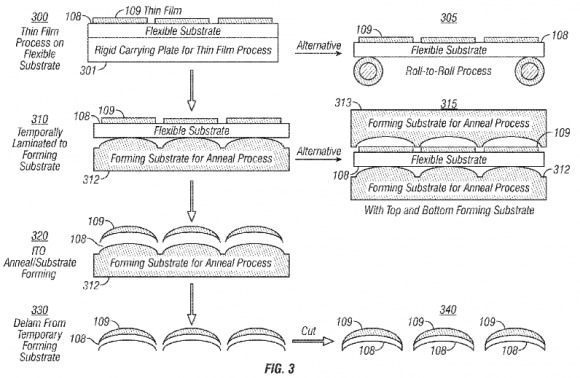Apple curved touch patent reawakens flexed iPhone and iWatch talk
Apple has patented a new type of curved touch sensor that could be used to make non-flat tablets, phones, displays, and even touch mice with bowed or molded glass. The new filing, No. 8,603,574, proposes a different method of manufacturing touch sensors that could effectively mold the panel to suit a curved glass smartphone, or indeed a smartwatch that contours to the wrist.
Traditionally, a touch panel is formed by layering multiple thin-film conductors over a flexible substrate, with minimal heating to work around damaging the sensitive components. Apple's evolution of the system, however, would start with a flat layering process but then fits it to a curved substrate to form the 3D shape, using heating to fix it as well as to make it more resilient and improve the optical qualities.
Although curved glass touchscreen devices have been produced before, Apple points out that they often don't actually have a curved touch panel. Instead, the glass is rounded but the touch sensor is flat, which can introduce a gap between the layers.
Apple's approach, therefore, would remove that gap and also open the door for more unusual form-factors. The process wouldn't be limited to a single curve, either, as with increasingly complex formers a single layer stack could be twisted in multiple directions, the company points out.

Other possibilities are using roll-to-roll processes with flexible substrates, effectively pinching the display layer in-between top and bottom formers. The temporary forming substrate would be removed once the touch sensor had been heat-fixed into shape.
Apple may not put the technology into practice, as is the case with any patented technology, but the company is no stranger to non-standard touch options. The Magic Mouse, for instance, has an entirely touch-sensitive top surface, though it's made of plastic not glass.
However, it's the potential for curved smartphones and wearables, like the much-rumored iWatch, that has many talking about the patented process. Curved phones like the LG G Flex we reviewed last week or Samsung's Galaxy Round are intriguing but not quite ready for the mass market, but one of the key selling points of the screen arrangement – that it makes reaching across it with a thumb more practical – could also be used by Apple to enlarge the iPhone display without reducing the all-important single-handed usability.
Two curved iPhones have already been rumored for 2014. Meanwhile, Apple has been rumored to be working with curved glass for its smartwatch before now, potentially bypassing the generally large face of existing smartwatch options by wrapping the display more closely to the wrist.
VIA AppleInsider
